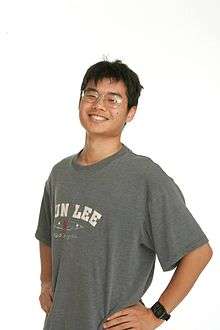Tyson Mao
Tyson Mao (born May 8, 1984, in San Francisco, California) is an American Rubik's Cube speedsolver. He is a co-founder and a former board member of the World Cube Association, an organization that holds competitive events for the Rubik's Cube. In 2005, he set the world record for 3x3x3 blindfolded.[1] In 2006, he appeared on the CW Television Network's "Beauty and the Geek" as one of the participants of the second incarnation of the reality television show.[2]
Tyson Mao | |
|---|---|
 | |
| Born | May 8, 1984 San Francisco, California, United States |
| Years active | 2006–present |
| Spouse(s) | Joyce Huynh |
Personal
Tyson Mao was born in San Francisco to immigrant parents from Tainan, Taiwan. He lives in the San Francisco Bay Area[3] and previously used to work as a Poker Product Manager for Zynga.[4] Mao graduated from the California Institute of Technology in 2006 with a degree in astrophysics. His father is a doctor based in South San Francisco.
Mao opened the Wursthall Restaurant & Bierhaus in San Mateo, CA with partners Adam Simpson and J. Kenji López-Alt.[5]
Rubik's Cube
Tyson began solving the cube during the Rubik's Cube's second boom in 2003, first using a beginner's method, then the Petrus and Fridrich methods. Tyson is credited for popularizing the "Caltech move" for solving the three diagonal corner permutation in blindfold solving.
Competition Organizer
Tyson has been the main organizer of major U.S competitions, including all US Nationals up to 2013, as well as many Caltech competitions.
Tyson Mao's beginner method
Tyson Mao's unofficial beginner method is a set of 8 videos which can be viewed at Rubiks.com. This method is most famous for being used by Will Smith in a past film The Pursuit of Happyness, that was released in 2006. The method is basically a simplified layer-by-layer approach which works much the same way as the Fridrich method. The difference is that the cross is first built around the opposite side to simplify the permutation foresight required, the first two layers are permuted individually, the last layer requires an algorithm to construct a cross, and then repetition of Lars Petrus' Sune algorithm to orient, and finally permutation requires the use of two algorithms, one for the corners and one for the edges. These algorithms may have to be executed multiple times.
Media appearances
- Beauty and the Geek Season 2
- CNN's Anderson Cooper 360° (Air date: December 15, 2006)
- Identity (game show)
- The Tonight Show with Jay Leno (Air date: January 27, 2006)
- Twins (TV series)
- USA Network: Show Us Your Character
- Good Morning America (Air date: February 4, 2008)
References
- "World Cube Association History for 3x3x3 Blindfolded World Record". World Cube Association. Retrieved 2016-02-02.
- Merrin, Tarra (2006-01-12). "'Beauty and the Geek' returns to TV". Canoe.ca. Archived from the original on 2007-10-18. Retrieved 2007-12-12.
- http://taiwaneseamerican.org/100people/tyson-mao/
- https://www.youtube.com/watch?v=iebzLsCEMB0&t=2m35s
- "Internet Food Guru J. Kenji Lopez-Alt Opening Real Life Beer and Sausage Hall". Eater SF. Retrieved 2017-12-27.
External links
- "Brain Trust Behind 'Beauty And The Geek' Says More Stereotype Breaking In Works". The Tampa Tribune. 18 January 2006. Archived from the original on 2006-02-14. Retrieved 2020-01-30.
- Brothers square off in cubing contest, San Francisco Chronicle
- Tyson Mao, entry on The Internet Movie Database
- Tyson's Blog
